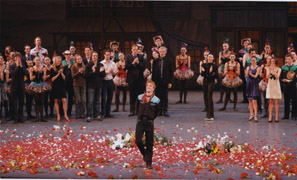
Jack Anderson
New York City Ballet: Two Premieres and a Farewell
 |
| Nikolaj Hubbe's farewell performance. Photo by Paul Kolnik. |
New York City Ballet
New York State Theater, Lincoln Center
Tuesdays and Wednesdays at 7:30 p.m., Thursdays and Fridays at 8 p.m.,
Saturdays at 2 and 8 p.m., Sundays at 3 p.m., $20-$98
Tickets: (212) 870-5550 or www.nycballet.com
Reviewed by Jack Anderson Feb. 11, 2008
The New York City Ballet's winter season featured two premieres (one big,
one little) and a farewell performance that left many cheering dancegoers
misty-eyed.
The more ambitious premiere was Mauro Bigonzetti's "Oltremare" (which can be translated as "overseas"). Although not entirely successful, it proved worth watching, also worth listening to, thanks to a moody commissioned score by Bruno Moretti rich in instrumental textures, including passages for the fisarmonica, an Italian accordion.
Wearing drab costumes by Bigonzetti and Marc Happel that evoked early 20th-century working-class attire, fourteen people with luggage appeared to be boarding a ship. They looked troubled, and the action suggested they might be immigrants fearfully voyaging to a new world.
Bigonzetti divided his cast into seven couples who came forward in restless duets, and there were especially lengthy ones for Maria Kowroski and Tyler Angle, and Tiler Peck and Amar Ramasar. This tidy and much too balletically conventional division made the work a collection of pas de deux, rather than a cross-section of worried voyagers. It also made everyone too similar and prevented Bigonzetti from showing different types of immigrant communities. Despite such limitations of choreographic variety and social commentary, Bigonzetti does appear to have a gift for establishing emotional atmosphere.
Christopher Wheeldon's last creation as the company's resident choreographer was "Rococo Variations," a trifle to Tchaikovsky's "Variations on a Rococo Theme," which received a surprisingly ragged performance, conducted by Paul Mann, with Fred Zlotkin as cello soloist. Wheeldon set two couples (Sterling Hyltin and Giovanni Villalobos and Sara Mearns and Adrian Danchig-Waring) dancing graciously, but not always interestingly, the choreography growing most imaginative when both couples were on stage in steps that complemented or mirrored one another. But neither couple had its own distinctive choreographic personality.
The theater was packed on February 10 when Nikolaj Hübbe gave his final performance as a regular member of the company. After a noble account of the title role of Balanchine's "Apollo," he showed his great versatility in three contrasting ballets. Peter Martins's "Zakouski" is choreographically negligible, yet it did display Hübbe's gift for timing. He looked tough and also sang well in the "Cool" episode from Jerome Robbins's "West Side Story Suite," and was a jolly cowboy in Balanchine's "Western Symphony." Hübbe's warm stage presence always equaled his strong technique. No wonder we shall miss him when he returns to his native Denmark to direct the Royal Danish Ballet.
That will mean, of course, supervising its great 19th-century
Bournonville ballets. His stylistic knowledge of that repertory was apparent
in a performance he had coached of the "Flower Festival in Genzano"
pas de deux with two young dancers, Kathryn Morgan and David Prottas.
Both possessed the unexaggerated charm and unforced technique that makes
Bournonville eternally appealing.
| museums | NYTW mail | recordings | coupons | publications | classified |
